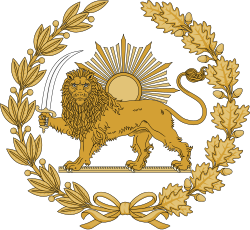狮子与太阳
此条目的引用需要清理,使其符合格式。 (2014年7月10日) |
此条目需要补充更多来源。 (2014年7月10日) |
狮子与太阳(波斯语:شیر و خورشید,Šir o Xoršid)是伊朗的一个主要象征,并且在1846年到1980年间是伊朗国旗上的主要元素。这个在古代和现代都被不断描绘的主题在十二世纪时成为了伊朗的流行符号。[1]狮日符号主要根据天文学和占星学结构绘制: 一种太阳在狮子宫的古老符号,[1][2]最早可追溯至巴比伦人的巴比伦占星术和近东传统。[2][3]
| 狮子与太阳 شیر و خورشید | |
|---|---|
 狮子与太阳 | |
| 细节 | |
| 启用 | 1846年(由穆罕默德沙·卡扎尔的法令启用) |
| 其他元素 | 太阳和爪持佩剑的狮子 |
| 使用 | 前伊朗军装,1846年到1980年间的伊朗国旗 |

该主题有许多历史意义。首先,它是一个占星术和黄道兼有的符号。在萨非沙阿和早期几个卡扎尔沙阿统治时期,它与什叶派的联系日益紧密。[1]在萨非王朝时期,狮日标志代表帝国的两大支柱——国家和伊斯兰宗教。它在卡扎尔王朝时期提擢为波斯的国家象征。十九世纪时,在卡扎尔沙阿庭院的欧洲游览者将狮日归类为遥远的古风;那时起,它引发了民族主义的解释。[1]但在法特赫-阿里沙·卡扎尔和他的继任者统治时期,这一主题却被大幅修改了。一个皇冠也被添加到这个符号上以宣示王权。法特赫-阿里统治早期,伊斯兰对帝国的影响逐渐式微。这一转变影响了这一符号的象征主题。该符号的象征意义在卡扎尔时期与1979年革命时期间不停转变。狮子可解释为比喻阿里,也可解释为那些随时保护国家抵御外敌的英雄们,还可解释为王权的古老象征。太阳也可选择性解释为国王,传说中的君主贾姆希德,或祖国。
该象征的许多历史解释为伊朗民族身份的象征竞争提供了坚实基础。二十世纪时,部分政治家和学者建议将诸如卡维之旗等其他物品设为国家象征,替代狮日。但是该标志却一直担任伊朗国家象征,直到1979年革命时狮子与太阳才被从公共场合和政府组织标识中抹去,代之以现在的伊朗国徽。
图集
编辑其他非伊朗变种
编辑参见
编辑注解
编辑- ^ 1.0 1.1 1.2 1.3 (Shahbazi 2001)
- ^ 2.0 2.1 (Kindermann 1986)
- ^ (Krappe 1945)
- ^ (Nafisi 1949)
参考资料
编辑- Babayan, Kathryn, Mystics, monarchs, and messiahs: cultural landscapes of early modern Iran, Harvard College: 491, 2002 [2014-07-10], ISBN 0-932885-28-4, (原始内容存档于2014-09-16)
- Barker, Patricia L., Islamic Textiles, British Museum Press: 137, 1995, ISBN 0-7141-2522-9
- Burchill, Richard, N. D. White, Justin Morris, H. McCoubrey, International conflict and security law: essays in memory of Hilaire McCoubrey, Vol. 10, Cambridge University Press: 92, 2005, ISBN 9780521845311
- Eskandari-Qajar, Manoutchehr M., Emblems of Qajar (Kadjar) Rulers: The Lion and the Sun, The Qajar(Kadjar) Pages, 2009 [2009-10-10], (原始内容存档于2021-02-25)
- Fuat Köprülü, Daneshnameye Jahan-e Eslam(Encyclopaedia of the World of Islam From Encyclopedia of Turk), Bayrak, The Encyclopaedia Islamica Foundation, (原始内容存档于2010-11-04) (波斯语)
- Joseph, Suad; Najmabadi, Afsaneh, Encyclopedia of Women & Islamic Cultures: Family, law, and politics, Netherlands: Brill Academic Publisher: 524, 2002
- Kindermann, H., Al-Asad, Encyclopedia of Islam 1, Leiden, the Netherlands: E.J.Brill: 681–3, 1986
- Khorasani, Manouchehr M., Arms and Armor from Iran: The Bronze Age to the End of the QajarPeriod. First, Germany: Verlag, 2006
- Krappe, Alexander H., The Anatolian Lion God, Journal of the American Oriental Society (American Oriental Society), Jul–Sep 1945,, Vol. 65, (No. 3): 144–154, JSTOR 595818
- Marashi, Afshin, Nationalizing Iran: Culture, Power, and the State, 1870-1940, Published by University of Washington Press, 2008
- Nafisi, Saeed, Derafsh-e Iran va Shir-o-Khoshid (The Banner of Iran and the Lion and the Sun), Tehran: Chap-e Rangin, 1949 (波斯语)
- Najmabadi, Afsaneh, II, Gender and sexual anxieties of Iranian Modernity, University of California Press, 2005, ISBN 0-520-24262-9
- Shahbazi, Shapur A., Flags (of Persia), E. Yarshater; et al (编), Encyclopaedia Iranica 10, 2001 [2014-07-10], (原始内容存档于2016-03-04)
外部链接
编辑- Shahbazi, Shapur A. Flags (of Persia). Encyclopaedia Iranica 10. 2001 [2014-07-10]. (原始内容存档于2016-03-04).